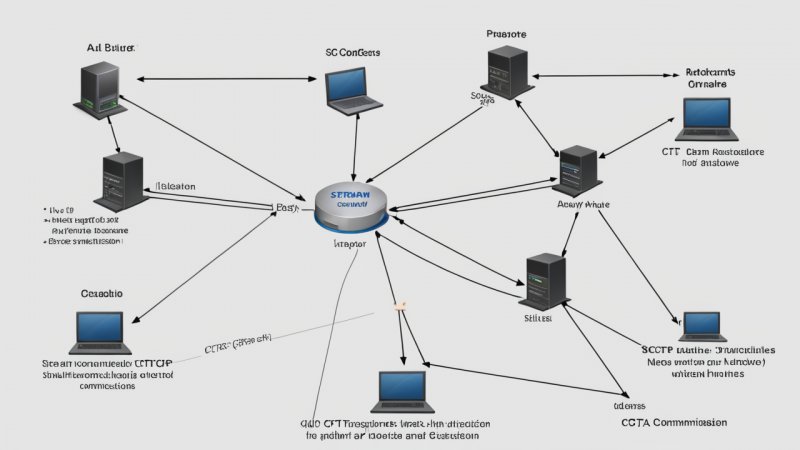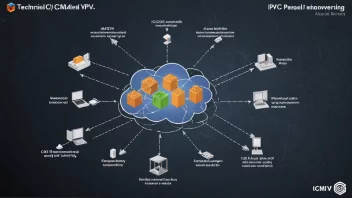Stream Control Transmission Protocol (SCTP) is a transport layer protocol that plays a critical role in modern network communications. Originally designed to transport telephony signaling messages over IP networks, SCTP has evolved to support a range of applications, including multimedia streaming, telecommunications, and data transmission in computer networks. Unlike its more widely known counterparts, TCP (Transmission Control Protocol) and UDP (User Datagram Protocol), SCTP offers unique features that enhance reliability, multi-streaming capabilities, and better congestion control mechanisms. This article delves into the architecture of SCTP, its key features, and its applications in contemporary transport layer protocols.
Understanding SCTP Architecture
SCTP operates at the transport layer of the OSI model and is defined in RFC 4960. Its architecture is designed to address the limitations of TCP and UDP, providing a more robust solution for data transmission across unreliable networks. SCTP is connection-oriented, allowing for the establishment of a session between two endpoints, which is essential for maintaining the integrity of data transfers.
Key Components of SCTP
The architecture of SCTP consists of several key components:
- Association: Unlike a connection in TCP, an SCTP association can support multiple streams of data. This allows for the simultaneous transmission of messages, reducing latency and improving efficiency.
- Streams: SCTP enables multiple streams within a single association, allowing messages to be delivered independently. This feature helps prevent head-of-line blocking that can occur in TCP.
- Chunk: Data is transmitted in units called chunks. Each chunk can contain different types of information, including user data, control messages, and acknowledgment messages.
- Packet Structure: SCTP packets encapsulate chunks and include headers that provide necessary control information, including source and destination ports, verification tags, and check sums.
Key Features of SCTP
SCTP is distinguished by several features that set it apart from traditional transport layer protocols:
Multi-homing
One of SCTP's most significant advantages is its support for multi-homing, which allows a single SCTP endpoint to be associated with multiple IP addresses. This capability enhances fault tolerance, as it enables the protocol to reroute traffic in the event of a link failure or network congestion. Multi-homing also provides load balancing across different network paths, optimizing resource utilization.
Multi-streaming
SCTP's multi-streaming feature allows multiple streams to be established within a single association, facilitating the parallel delivery of messages. This capability reduces the chances of head-of-line blocking, where the delay of one message can hold up the entire transmission. Applications that require low latency, such as video conferencing or online gaming, can benefit significantly from this feature.
Message-oriented Communication
Unlike TCP, which is byte-oriented, SCTP is message-oriented, meaning it preserves message boundaries during transmission. This feature is particularly useful for applications that require the delivery of distinct messages without being broken into smaller packets. It simplifies the application layer's handling of data and enhances the overall efficiency of communication.
Reliable Delivery and Congestion Control
SCTP provides mechanisms for reliable message delivery, including built-in acknowledgment and retransmission strategies. It employs a selective acknowledgment (SACK) scheme, where only the missing packets are retransmitted, reducing unnecessary data transmission. Additionally, SCTP incorporates advanced congestion control algorithms to optimize throughput and minimize packet loss, making it a suitable choice for high-performance applications.
Applications of SCTP
With its unique features, SCTP has found applications in various domains:
Telecommunications
Initially designed for telephony signaling, SCTP is widely used in telecommunications networks for transporting SS7 signaling messages. Its reliability and multi-homing capabilities make it an ideal choice for signaling transport across different network paths.
WebRTC
Web Real-Time Communication (WebRTC) is a technology that enables peer-to-peer connections for audio, video, and data sharing in web applications. SCTP plays a critical role in WebRTC, providing the underlying transport for data channels that require low latency and high reliability.
Streaming Services
In multimedia streaming, SCTP's multi-streaming capability allows for the simultaneous delivery of audio and video streams, improving user experience by reducing buffering and delays. Streaming services can leverage SCTP to enhance the reliability of content delivery.
Challenges and Considerations
Despite its advantages, SCTP also faces challenges that need to be addressed for broader adoption:
Deployment Complexity
Implementing SCTP can be more complex than deploying TCP or UDP, particularly in legacy systems that may not support it. Network administrators and developers must be knowledgeable about SCTP's architecture and configuration to leverage its full potential.
Firewall and NAT Issues
SCTP's multi-homing and message-oriented features can create challenges with firewalls and Network Address Translation (NAT) devices. Many firewalls are configured primarily to handle TCP and UDP traffic, potentially blocking SCTP packets. Strategies for overcoming these obstacles must be developed to facilitate SCTP's use in diverse environments.
Case Studies
To illustrate the practical applications of SCTP, let's explore a couple of case studies:
Case Study 1: Telecommunications Network Upgrade
A telecommunications provider sought to upgrade its signaling transport infrastructure to improve reliability and reduce downtime. By adopting SCTP for its signaling transport, the provider was able to implement multi-homing, ensuring that signaling messages could be rerouted in real-time in the event of a failure. As a result, the provider reported a 30% reduction in signaling downtime and improved overall network performance.
Case Study 2: WebRTC Implementation for Online Education
An online education platform integrated WebRTC to enable real-time video and data sharing between instructors and students. By utilizing SCTP for data channels, the platform achieved low-latency communication and enhanced the user experience. Feedback from users indicated a significant improvement in the quality of interactions during live sessions, leading to higher engagement and satisfaction rates.
Conclusion
SCTP is a versatile transport layer protocol that offers significant advantages over traditional protocols like TCP and UDP. Its support for multi-homing, multi-streaming, and message-oriented communication makes it a compelling choice for modern network applications, particularly in telecommunications and real-time communications. While challenges remain in terms of deployment and interoperability, the continued evolution of SCTP will likely see broader adoption across various industries. As networks become more complex and the demand for reliable and efficient data transmission grows, SCTP will play an increasingly important role in shaping the future of transport layer protocols.






